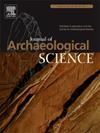Bioarchaeological insights into Late Eneolithic violence: Analysing a grave from the Sadowie cemetery, Poland
IF 2.6
1区 地球科学
Q1 ANTHROPOLOGY
引用次数: 0
Abstract
This study examines a grave of the Złota culture from the Late Eneolithic period (the first half of the 3rd millennium BC), discovered at a cemetery in Sadowie, southeastern Poland. The deliberately constructed grave chamber contained the remains of six individuals of varying sex and age: five males and one female. Evidence of fatal injuries was observed on the skulls of three individuals, while flint arrowheads were embedded in the postcranial skeletons of two others. Interdisciplinary studies were conducted to investigate the biological characteristics of the buried individuals and the circumstances surrounding their deaths. Genetic analyses indicated kinship ties between some of the individuals. Strontium isotope analyses revealed that most of the individuals were local to the Sadowie area, with the exception of one female who was identified as non-local. Stable carbon and nitrogen isotope ratios in bone collagen revealed that the individuals had similar diets, predominantly based on C3 plants, with notable contributions from animal protein, likely derived from herbivorous meat and/or dairy products. The studied burial provides further evidence of prehistoric violence among Late Eneolithic communities.
新石器时代晚期暴力的生物考古学见解:分析波兰Sadowie墓地的坟墓
本研究考察了在波兰东南部Sadowie的一个墓地中发现的一座新石器时代晚期(公元前3千年上半叶)Złota文化的坟墓。这个故意建造的墓室里有6具不同性别和年龄的遗骸:5名男性和1名女性。在三个人的头骨上发现了致命伤的证据,而在另外两个人的颅后骨骼中发现了燧石箭头。进行了跨学科研究,以调查被埋葬的人的生物学特征及其死亡的情况。遗传分析表明,一些个体之间存在亲属关系。锶同位素分析显示,大多数个体都是Sadowie地区的当地人,除了一名女性被确定为非当地人。骨胶原中稳定的碳和氮同位素比率表明,这些个体的饮食相似,主要以C3植物为基础,动物蛋白的贡献显著,可能来自食草肉类和/或乳制品。研究的墓葬为新石器时代晚期的史前暴力提供了进一步的证据。
本文章由计算机程序翻译,如有差异,请以英文原文为准。
求助全文
约1分钟内获得全文
求助全文
来源期刊

Journal of Archaeological Science
地学-地球科学综合
CiteScore
6.10
自引率
7.10%
发文量
112
审稿时长
49 days
期刊介绍:
The Journal of Archaeological Science is aimed at archaeologists and scientists with particular interests in advancing the development and application of scientific techniques and methodologies to all areas of archaeology. This established monthly journal publishes focus articles, original research papers and major review articles, of wide archaeological significance. The journal provides an international forum for archaeologists and scientists from widely different scientific backgrounds who share a common interest in developing and applying scientific methods to inform major debates through improving the quality and reliability of scientific information derived from archaeological research.
 求助内容:
求助内容: 应助结果提醒方式:
应助结果提醒方式:


